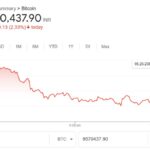The Indian equity markets opened lower on Monday, with benchmark indices retreating from recent highs as foreign investors continued their selling spree and domestic profit-taking accelerated. The stock market today registered a pessimistic start to the final two months of the financial year, with the BSE Sensex declining 217.39 points, or 0.26 percent, to 83,721.32, while the NSE Nifty 50 fell 46.40 points, or 0.18%, to settle below the psychologically important 25,700 level at 25,675.70 during early morning trade.
This muted opening comes after a robust October performance that had propelled both Sensex today and Nifty 50 today to near record-high levels, prompting investors to take profits and lock in gains accumulated over the strong quarter. The corrective move reflects a confluence of domestic and international factors that have collectively dampened investor sentiment and created headwinds for equity valuations across the board.
Market Opening and Breadth Indicators
The Indian stock market today displayed a mixed picture despite headline index weakness. While the major indices declined, market breadth statistics revealed selective strength in mid-cap and small-cap segments. Approximately 1,457 stocks advanced during early trade against 1,077 declining issues, with 243 remaining unchanged. This divergence suggests that profit-taking was concentrated in large-cap stocks, while value-conscious investors continued accumulating positions in lower-priced securities.
The BSE Midcap index advanced 43.82 points, or 0.09 percent, while the BSE Smallcap index gained 61.77 points, or 0.11 percent, indicating a classic rotation pattern where domestic investors redistributed capital from expensive large caps toward relatively cheaper mid- and small-cap alternatives. This tactical reallocation represents normal market behavior during correction phases and suggests underlying investor confidence in India’s long-term growth narrative remains intact.
GIFT Nifty futures had initially signalled a negative start, trading 43.5 points lower at 25,853.5 levels before the market open, providing traders advance warning of weakness ahead. This forward-looking indicator from global markets accurately predicted the opening direction, underscoring investor caution regarding global economic developments and their potential spillover effects on emerging market equities.
FPI Selling Pressure and Capital Flows
The primary catalyst driving profit-taking selling in the Indian equity market stems from persistent foreign portfolio investor (FPI) offloading. According to the latest exchange data released by market operators, FPIs offloaded equities worth ₹6,769.34 crore on October 31, 2025, marking a significant portfolio reduction by international fund managers. This represents a continuation of the broader trend observed throughout late October, where foreign investors systematically reduced Indian equity exposure.
FPI outflow India accelerated due to multiple global factors simultaneously pressuring foreign investors’ appetite for emerging market securities. The persistence of elevated U.S. Treasury yields, maintaining levels around 4.2 to 4.5% across the yield curve, has increasingly made fixed-income instruments attractive to global capital allocators. With risk-free returns available at such levels, alternative assets like equities must offer compensatory risk premiums, particularly in emerging markets prone to currency and political volatility.
The hawkish tone from U.S. Federal Reserve communications regarding December interest rate reduction prospects has further cooled foreign investor enthusiasm. Market participants have adjusted expectations for additional Fed rate cuts, with the December rate reduction probability dropping to approximately 25%, suggesting that U.S. interest rates may remain elevated for an extended period. This monetary policy outlook reduces the relative attractiveness of emerging market equities that typically perform better during easy monetary conditions.
Domestic Support and DII Buying
Contrasting with foreign selling, Domestic Institutional Investors (DIIs) demonstrated consistent support for Indian equities, offsetting some of the FPI pressure. DIIs purchased equities worth ₹7,068.44 crore on October 31, exceeding FPI selling volumes and demonstrating confidence in India’s fundamentals. This domestic buying suggests that local investors, including mutual funds and insurance companies, view current valuations as attractive despite headline index weakness.
The DII buying pattern reflects India-specific investment theses that remain robust despite temporary market corrections. Domestic investors cite steady corporate earnings growth, improving macroeconomic indicators, and structural advantages related to India’s demographic dividend and manufacturing potential as supporting long-term equity investments. This domestic-foreign investor divergence is not unusual during correction phases and historically has preceded market recoveries as foreign selling exhausts itself.
Sectoral Performance and Stock-Specific Movements
Within the stock market today context, sectoral dynamics revealed interesting divergence with selective strength in automotive and financial services stocks. Mahindra & Mahindra led gainers with appreciation exceeding 2.63 percent, supported by strong October automotive sales data showing remarkable two-wheeler registration growth of 52% year-on-year. This robust sales performance reflected post-GST tax reduction benefits and sustained festive season demand.
State Bank of India, Bharat Electronics Limited, and Tata Motors Passenger Vehicle also traded higher, benefiting from positive earnings outlooks and strong fundamentals. These stocks demonstrated resilience during broader market correction, indicating selective fund flows toward quality companies with proven earnings delivery.
Conversely, technology and selective auto component stocks experienced selling pressure. Maruti Suzuki declined 2.13% despite strong segment sales, as investors booked profits following a strong October rally. Tech Mahindra, Axis Bank, HCL Technologies, and ITC also weakened, reflecting typical profit-taking selling patterns in stocks with extended bull runs preceding correction phases.
Global Market Context
International equity markets provided mixed signals that failed to provide strong conviction either way for Indian investors. U.S. indices closed Friday with marginal movements—Nasdaq Composite advanced 0.61 percent, S&P 500 gained 0.26 percent, while Dow Jones settled nearly flat. These modest moves suggested caution among global investors as they awaited key economic data and Fed communications.
However, Asian markets demonstrated relative resilience on Monday morning, with South Korea’s KOSPI index surging 2.15%, Japan’s Nikkei 225 gaining 2.12%, and Hong Kong’s Hang Seng advancing 0.55 percent. This strength in Asian bourses, combined with domestic DII support, suggests that Indian equity weakness may represent routine correction rather than structural trend reversal.
Market Outlook and Investor Implications
The stock market‘s correction today appears driven by profit-taking following October’s strong rally and macroeconomic caution rather than deteriorating business fundamentals. With Q2 FY26 earnings season progressing, management commentary from major corporations will prove critical in determining whether current weakness translates into a sustained selloff or a healthy consolidation phase.
Investors should monitor key economic indicators, including consumer inflation, manufacturing output, and services sector purchasing managers’ indices, for additional cues regarding economic momentum. Further, Fed policy communications will remain crucial in determining foreign investor appetite for emerging market equities. Current valuations in quality companies experiencing temporary weakness may represent attractive entry points for long-term investors maintaining conviction in India’s growth story.
The corrective move in Sensex today and Nifty 50 today should be viewed within the broader context of strong year-to-date performance and underlying earnings growth supporting Indian equities at current valuation multiples.























